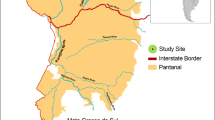Summary
Structure of breeding bird communities was compared among four habitat types representative of stages present in most old-field successions in the eastern deciduous forest formation of North America. The successional catagories, defined by vegetational structure, were designated herbaceous (type A habitats) herb, shrub and sapling (type B), young forest (type C), and older forest (type D). Density of breeding birds was lowest in A habitats, rose sharply in B habitats and reached a maximum in D habitats. Species richness and number of feeding guild showed similar patterns. Mean number of species per guilds was highest in D habitats. Generalist feeding guilds were predominant in type A and B habitats, primarily due to the importance of the graminivore-insectivore guild. Specialist guilds increased in importance with succession due to addition of several insectivorous guilds in later successional stages. Patterns of occurrence of individual feeding guilds are analyzed and discussed with respect to changes in vegetational structure. Variance in community structure was generally highest in A habitats and lowest in D habitats; this is discussed in relation to the evolution of “saturated”, coadapted communities.
Similar content being viewed by others
References
Aber JD (1979) Foliage-height profiles and succession in northern hardwood forests. Ecology 60:18–23
Adams CC (1908) The ecological succession of birds. Auk 25:109–153
Bard GE (1952) Secondary succession on the piedmont of New Jersey. Ecol Monogr 22:195–215
Beedy EC (1981) Bird communities and forest structure in the Sierra Nevada of California. Condor 83:97–105
Cody ML (1966) On the methods of resource division in grassland bird communities. Am Nat 102:107–147
Cody ML (1974) Competition and the Structure of Bird Communities. Princeton University Press, Princeton, NJ
Conner EF, McCoy ED (1979) The statistics and biology of the species-area relationship. Am Nat 118:791–833
Dale EE, Jr, Fullerton T (1964) Final report on ecological investigations on existing vegetation in the preimpoundment and watershed area of Beaver Lake. Contract 14-16-008-626, Bur Sports Fish Wild and Univ Arkansas
Egler FE (1981) Letter to the editor. Bull Ecol Soc Am 62:230–232
Faaborg J (1977) Metabolic rates, resources and the occurrence of non-passerines in terrestrial avian communities. Am Nat 111:903–916
Holmes RT, Bonney RE, Jr, Pacala SW (1979) Guild structure of the Hubbard Brook bird community: a multivariate approach. Ecology 60:512–520
James FC, Rathbun S (1981) Rarefaction, relative abundance, and diversity of avian communities. Auk 98:785–800
Johnston DW, Odum EP (1956) Breeding bird populations in relation to succession on the piedmont of Georgia. Ecology 37:50–62
Karr JR (1968) Habitat and avian diversity on strip-mined land in eastcentral Illinois. Condor 70:348–357
Karr JR (1971) Structure of avian communities in selected Panama and Illinois habitats. Ecol Monogr 41:207–233
Kendeigh SC (1946) Breeding birds of the beech-maple-hemlock community. Ecology 27:226–245
Klopfer PH, MacArthur RH (1959) Niche size and faunal diversity. Am Nat 106:79–88
Kricher JC (1973) Summer bird species diversity in relation to secondary succession on the New Jersey piedmont. Am Midl Nat 89:121–137
MacArthur RH (1958) Population ecology of some warblers of northeastern coniferous forests. Ecology 39:599–619
MacArthur RH (1964) Environmental factors affecting bird species diversity. Am Nat 98:387–397
Martin AC, Zim HS, Nelson AL (1951) American wildlife and plants. Dover Publ. New York
McIntosh RP (1980) The relationships between succession and the recovery process in ecosystems. In: Cairns J (ed) The Recovery Process in Damaged Ecosystems. Ann Arbor Sci. Pub. AnnArbor, Michigan, pp 11–62
McNaughton SJ, Wolf LL (1970) Dominance and the niche in ecological systems. Science 167:131–139
Morse DH (1968) A quantitative study of foraging of male and female sprucewood warblers. Ecology 49:770–784
Odum EP (1950) Bird populations of the Highlands (North Carolina) plateau in relation to plant succession and avian invasion. Ecology 31:587–605
Odum EP (1969) The strategy of ecosystem development. Science 164:262–270
Oosting HJ (1942) An ecological analysis of the plant communities of Piedmont, North Carolina. Am Midl Nat 28:1–126
Pianka ER (1978) Evolutionary Ecology. Harper and Row, Pub. New York
Pickett STA (1976) Succession: An evolutionary interpretation. Am Nat 110:107–119
Quartermain E (1957) Early plant succession on abandoned cropland in the central basin of Tennessee. Ecology 38:300–309
Rabenold KN (1978) Foraging strategies, diversity and seasonality in bird communities of Appalachian spruce-fir forests. Ecol Monogr 48:397–424
Robbins CS (1978) Census techniques for forest birds. In: DeGraaf CRM (ed) Proceedings of a workshop on the management of Southern Forests for Non-Game birds. USDA Forest Service Gen. Tech. Report SE-14, pp 142–163
Root RJ (1967) The niche exploitation pattern of the blue-gray gnatcatcher. Ecol Monogr 37:317–350
Rotenberry JT (1980) Dietary relationships among shrubsteppe passerine birds: Competition or opportunism in a variable environment? Ecol Mongr 50:93–110
Saunders AA (1936) Ecology of the birds of Quaker Run Valley Alleghany State Park, New York, Hand. St. Mus., Albany 16:1–174
Schoener TW (1974) Resource partitioning in ecological communities. Science 185:27–39
Shugart HH, Jr, James D (1973) Ecological succession of breeding bird populations in northwestern Arkansas. Auk 90:62–77
Smith KG, MacMahon JA (1981) Bird communities along a montane sere: Community structure and energetics. Auk 98:8–28
Stiles EW (1980) Bird community structure in alder forests in Washington. Condor 82:20–31
Van Velzen WT (1972) Breeding bird census instructions Am Birds 26:1007–1010
Whittaker RH, Goodman D (1979) Classifying species according to their demographic strategy. I. Population fluctuations and environmental heterogeneity. Am Nat 113:185–200
Wiens JA (1974) Climatic instability and the “ecological saturation” of bird communities in North American grasslands. Condor 76:385–400
Wiens JA (1976) Population responses to patchy environments. Annu Rev Ecol Syst 7:81–120
Wiens JA, Rotenberry JT (1980) Patterns of morphology and ecology in grassland and shrubsteppe bird populations. Ecol Monogr 50:287–308
Williamson P (1971) Feeding ecology of the red-eyed vireo (Vireo olivaceous) and associated foliage-gleaning birds Ecol Mongr 41:129–152
Willson MF (1974) Avian community organization and habitat structure. Ecology 55:1017–1029
Willson MF, Karr JR, Roth RR (1975) Ecological aspects of avian bill size variation. Wilson Bull 87:32–44
Author information
Authors and Affiliations
Rights and permissions
About this article
Cite this article
May, P.G. Secondary succession and breeding bird community structure: Patterns of resource utilization. Oecologia 55, 208–216 (1982). https://doi.org/10.1007/BF00384489
Received:
Issue Date:
DOI: https://doi.org/10.1007/BF00384489



